iPhone SE 2020 vs. iPhone 7: Should you upgrade?
The iPhone SE 2020 may look like the iPhone 7, but that’s where the similarities end
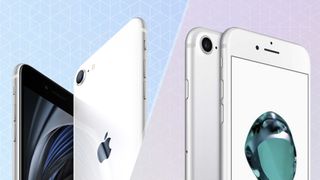
Anyone who thinks Apple doesn't release affordable phones should get familiar with the iPhone SE 2020. Released nearly two years ago, this compact iPhone featured specs that matched the leading iPhones at the time for a very low price. These days, the iPhone SE's $399 cost is $300 less than the $699 iPhone 13 mini.
That makes the iPhone SE a pretty compelling option for budget-minded users, particularly those still holding on to the iPhone 7. That phone is now more than five years old, but with people holding on to their handsets for longer periods of time, we're pretty sure there are still iPhone 7 and iPhone 7 Plus models out there — especially since those phones can run iOS 15, the current version of Apple's iPhone software.
- The best iPhones you can buy right now
- iPhone 12 vs. iPhone 8: Should you upgrade?
If it's time for you to upgrade from that older phone, the iPhone SE is certainly going to be a step up from what you have now. Even so, it helps to look at any iPhone SE vs. iPhone 7 differences to get a sense of just how big a leap forward you'll be making.
Here's a closer look at the improvements Apple has made with the iPhone SE to its flagship device from a few years ago. If you are considering an upgrade and weren't swayed by the iPhone 13 release in the fall, you may want to wait a few months longer, as the iPhone SE 3 is expected to arrive this spring.
iPhone SE 2020 vs. iPhone 7: Specs compared
| Row 0 - Cell 0 | iPhone SE 2020 | iPhone 7 |
| Screen size (Resolution) | 4.7-inch Retina HD (1334 by 750) | 4.7-inch Retina HD (1334 by 750) |
| CPU | A13 Bionic | A10 Fusion |
| RAM | 3GB (rumored) | 2GB |
| Storage | 64GB, 128GB, 256GB | 32GB, 128GB, 256GB |
| Rear camera | 12MP (f/1.8) | 12MP (f/1.8) |
| Front camera | 7MP (f/2.2) | 7MP (f/2.2) |
| Battery size | 1,821 mAh | 1,960 mAh |
| Size/Weight | 5.45 x 2.65 x 0.29 inches/5.22 ounces | 5.44 x 2.64 x 0.28 inches/4.87 ounces |
| Colors | Black, White, Product Red | Jet Black, Black, Silver, Gold, Rose Gold, Product Red |
iPhone SE 2020 vs. iPhone 7: Price
The iPhone SE starts at $399 for a 64GB version. Double the storage to 128GB and you'll pay $449. The 256GB model costs $549. Even with new iPhone models out, Apple has held the price on the iPhone SE — only the iPhone XR ($499) and iPhone 11 ($599) have seen price cuts.
Because the iPhone SE has been out for just about two years, we're now seeing discounts, mostly in the form of rebates if you trade in a device when buying the iPhone SE from a carrier. We're tracking the best iPhone SE deals around.
The iPhone SE costs less than what Apple charged for the iPhone 7 when that phone debuted at in 2016. Back then, the iPhone 7 started at $649, though obviously the price has fallen as newer models have come out. These days, you can find an iPhone 7 for less than $200 at discount carriers and retail sites, though in many cases, you'll be picking up a used model.
There’s one thing about the iPhone SE's price that's especially relevant to iPhone 7 users: Apple is offering a discount on its new phone when you trade in older models. iPhone 7 owners can knock off as much as $40 from the price of their iPhone SE, while the iPhone 7 Plus fetches up to $100 in rebates.
iPhone SE 2020 vs. iPhone 7: Design and display
While the iPhone SE is most notable for co-opting the iPhone 8's design, that's essentially the look and feel of the iPhone 7, too — a 4.7-inch screen surrounded by chunky bezels on the top and bottom. Below the screen, there's a Touch ID-supporting home button. It's as if the iPhone X-style designs of the past few years never happened at all.
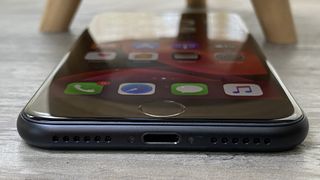
Put the iPhone 7 and iPhone SE 2020 side-by-side and you'd need a very good ruler to detect any size disparities. There's only fractional differences between the 5.45 x 2.65 x 0.29-inch iPhone SE and the 5.44 x 2.64 x 0.28-inch iPhone 7. The new iPhone weighs a little bit more, at 5.22 ounces to the iPhone 7's 4.87-ounce weight.
On paper, the screens would appear to be the same, as both phones feature LCD panels with 1334 x 750 resolution. But there have been advances in display technology since the iPhone 7 first came out. The iPhone SE supports True Tone, allowing it to adjust color temperature on the display based on ambient lighting.
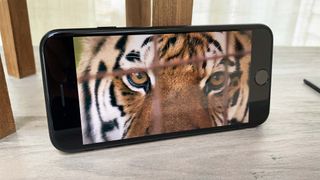
For what it's worth, the iPhone SE screen is somewhat brighter than the iPhone 7's, measuring at 653 nits with a light meter. When we tested an iPhone 7 Plus back in 2016, that phone topped out at 578 nits. The LCD panels on both phones captured comparable percentages of the sRGB color spectrum, so you won't see much difference in color range.
Other design elements of the iPhone SE will be familiar to iPhone 7 owners, for good and for bad. The newer phone has an IP67 water-resistance rating, meaning a dunk in 1 meter of water for 30 minutes shouldn't pose a problem. That's unchanged from the iPhone 7, as is the lack of a headphone jack on either phone.
iPhone SE 2020 vs. iPhone 7: Cameras
Here's where the new begins to distance itself from the old. The iPhone SE features a single rear camera, much like the iPhone 7 did. (The iPhone 7 Plus actually one-ups the iPhone SE with a second telephoto lens that provides a true optical zoom.) But while the iPhone SE and iPhone 7 both sport 12MP lenses with apertures of f/1.8, that's where the similarities end.

For starters, the iPhone SE's rear sensor has more in common with the single rear lens Apple included in 2018's iPhone XR, and that phone definitely improved upon the picture-taking skills of previous single-lens iPhones. In addition the A13 Bionic processor powering the iPhone SE — more on that improvement in a moment — helps with computational photography by way of the chipset's built-in neural engine.
With the iPhone SE's camera, you'll get Smart HDR, which can highlight more details in the faces of the people you photograph. The iPhone SE can also create lighting effects and control the depth of field on portraits. You'll also be able to take portrait shots with both the rear and 7MP front camera on the iPhone SE. All of that's beyond the skill set of the iPhone 7.
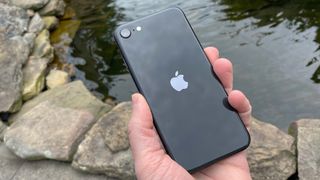
The biggest missing feature on the iPhone SE — well, aside from that second lens — is support for the Night mode rolled out with last year's iPhone 11 models. That means when you're in a darkly lit room, you'll need to rely on the iPhone SE's flash. That's not a feature the iPhone 7 offered either, so it's not like anyone upgrading phones will miss what they never had.
We don't have an iPhone 7 handy to shoot photo comparisons, but the head-to-head comparisons we've done with the new iPhone SE and other phones have convinced us that it belongs on the list of best camera phones, even with its lone rear lens. At this point, though, the Pixel 5a from Google is the better low-cost camera option.
iPhone SE 2020 vs. iPhone 7: Performance and software
The iPhone SE 2020 features the A13 Bionic processor, the same Apple-designed chipset that powers the iPhone 11, iPhone 11 Pro and iPhone 11 Pro Max. Prior to the release of the iPhone 12 and iPhone 13 with their superior chips, the A13 produced the best results at the time for our our mobile benchmarks. Even though the iPhone 13 now reigns as the speed king thanks to its A15 Bionic chip, it's safe to say the iPhone SE dusts the iPhone 7 and its A10 Fusion chip.
According to Apple, the iPhone SE offers up to 1.8 times the CPU performance of the iPhone 7 and iPhone 7 Plus and up to 2.8 times the graphics power.
Put another way, the iPhone SE scored 3,226 on the multi-core test and 1,337 on the single-core portion of the Geekbench 5 performance test. Those numbers are comparable to what the iPhone 11 put up. We imagine the iPhone 7 would have a hard time keeping pace with its 4.5-year-old processor.
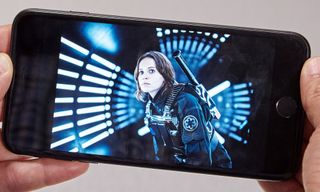
The base model of the iPhone SE features double the storage of the paltry 32MB that the iPhone 7 offered. However, the iPhone 7 did come in 128GB and 256GB capacities as well, matching Apple's latest phone.
The software experience on both phones is pretty much the same. As we mentioned, the iPhone 7 is capable of running iOS 15, though apps will probably be a little peppier on the newer iPhone SE. Also, some functions of iOS 15 won't work on the iPhone 7, as they require at least an A12-powered iPhone.
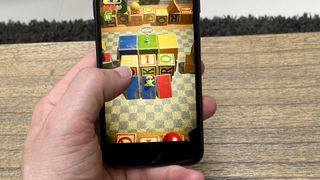
iOS 16 is expected to come out later this year, and we figure that Apple will still support the iPhone SE 2020. (The original iPhone SE won't be so lucky, we hear.) The iPhone 7 is likely to make the cutoff for iOS 16 support, but just barely, according to rumors.
iPhone SE 2020 vs. iPhone 7: Battery life and charging
Here's one area where iPhone 7 users who upgrade to the iPhone SE might not notice much of a difference. The iPhone SE has an 1,821 mAh battery, according to teardowns. (Apple never discloses battery size.) That's actually smaller than the 1,960 mAh power pack in the iPhone 7.
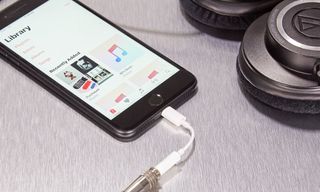
Apple says the iPhone SE should have about the same battery life as the iPhone 8, which showed a marginal improvement over the iPhone 7 when we ran our tests years ago. To that end, the iPhone SE averaged 9 hours, 18 minutes on our battery test involving continuous surfing over LTE. That's below average for a current smartphone and well behind what the iPhone 11 delivers.
The iPhone SE 2020 can boast something the iPhone 7 doesn't have — wireless charging support. Using any Qi-compatible charger, you can juice up your iPhone SE without wires. That's good because the wired charger that ships with the iPhone SE is the same old 5-watt Lightning charger as before. If you want to charge your new phone faster, you'll have to pay for an 18-watt charger separately.
iPhone SE 2020 vs. iPhone 7 verdict: Upgrade or turn to another iPhone?
Although it looks similar to the iPhone 7, the iPhone SE is a big leap forward from Apple's flagship from a few years ago, and a better bargain to boot. You get much faster performance, better cameras and wireless charging support, making for a more future-proof phone in the iPhone SE.
But upgrading isn't as cut-and-dried as it might have been a few months back. We're hearing more about a new version of the iPhone SE that's coming in early 2022. And while the iPhone SE 3 is unlikely to introduce a new design, we would expect it to adopt the A15 Bionic chip found in the current top-of-the-line iPhones. That means 5G compatibility, which is missing from the current iPhone SE.
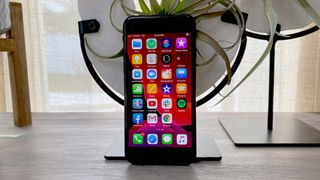
There's also the fact that Apple has released other iPhones since the iPhone SE's 2020 release. These include the iPhone 12 mini and iPhone 13 mini, both of which are more compact than the SE. They're not as cheap, though — we've mentioned the iPhone 13 mini's $699 price, and the iPhone 12 mini costs $599.
And that brings us back to the iPhone SE 2020's big appeal — the way it balances value with a compact size. If you appreciate smaller phones and don't want to pay top dollar, the iPhone SE is a worthwhile improvement over the iPhone 7 — though the iPhone SE 3's promise makes it worth waiting for that phone's expected launch.
Sign up to get the BEST of Tom's Guide direct to your inbox.
Get instant access to breaking news, the hottest reviews, great deals and helpful tips.
Philip Michaels is a Managing Editor at Tom's Guide. He's been covering personal technology since 1999 and was in the building when Steve Jobs showed off the iPhone for the first time. He's been evaluating smartphones since that first iPhone debuted in 2007, and he's been following phone carriers and smartphone plans since 2015. He has strong opinions about Apple, the Oakland Athletics, old movies and proper butchery techniques. Follow him at @PhilipMichaels.
